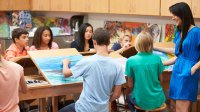Developing Curricula for SEL and the Arts
Educators are working to encourage the development of social and emotional learning competencies through arts education.
Your content has been saved!
Go to My Saved Content.Many arts educators I know informally and pragmatically seek to build social and emotional learning (SEL) skills to help their students appreciate the nuances of art, often by attending to the way emotions are expressed in painting, sculpture, drawing, music, and dance. Teachers of the arts know that observing, analyzing, and understanding art and its production and context builds many SEL competencies. Arts educators know also that building students’ SEL capacities will often increase their appreciation of and participation in the arts.
In my home state of New Jersey, there are currently efforts to bring arts education and SEL into better alignment. Arts Ed NJ and SEL4NJ are collaborating to create a pathway between the arts and social and emotional learning competencies. As these organizations work together, a pathway is being designed to tie specific arts activities to visual and performance arts state standards and SEL competencies.
In the SEL area of social awareness, four competencies have been identified:
- Recognize one’s feelings and thoughts.
- Recognize the impact of one’s feelings and thoughts on one’s own behavior.
- Recognize one’s personal traits, strengths, and limitations.
- Recognize the importance of self-confidence in handling daily tasks and challenges.
Consider how these four competencies could be applied to listening to a piece of music. Students could note their emotions, consider how what they heard led to those feelings, relate to other times they listened to music and felt something similar (or different), and practice how they can express their views with confidence.
I recently attended a Very Young People’s Concert with my 4-year-old grandson, and the musicians played excerpts from the Nutcracker ballet by Tchaikovsky. Kids not previously familiar with a piece of music, or a song, could identify a range of feelings that different parts of the music evoked in them. With practice, they can expand the initial feelings they express, as well as learn from their classmates.
Examples From Different Grades
To further illustrate the synergy between arts education and SEL, consider the following scenarios.
Elementary grades: It is a shared goal among arts educators and those concerned about SEL that all students build their vocabulary for emotions and feelings. And we can begin this with young children. To the extent that students label works of art as good or bad, or say that seeing or hearing visual or performing arts media leads them to feel sad, mad, or glad, they are limiting what they will absorb from the world around them. They will be less likely to appreciate works of art they experience, and they will be less likely to understand the nuances of relationships they experience.
What this means is that from early on, teachers in arts classes need to be looking to expand the vocabulary of students. For example, some curricula suggest that by the end of first grade, children should, at the least, know and use the words sad, mad, happy, surprised, worried, afraid, upset, and proud.
In an early elementary art class, children can be helped to understand depictions of these feelings in pictures but also in abstract art, making linkages to certain colors and color combinations as well. Collaborating teachers can design ways for students to understand how to detect these feelings in picture books. The Cat in the Hat and other Dr. Seuss books have excellent illustrations of feelings.
Middle and high school grades: In a two-day lesson titled Building SECD Skills Via Analyzing and Creating Art, students examine paintings by Norman Rockwell depicting the Four Freedoms during World War II. This lesson illustrates how teachers of the arts can collaborate with core subject area educators (language arts or social studies) in building SEL competencies.
For the assessment part of this lesson, students create their own contemporary Four Freedoms representations. Students might do this through collage, photography, spoken word, or even dance. Arts educators can greatly deepen students’ ability to analyze the paintings as the students plan their own artistic representations. The core subject teachers can help the lesson articulate the school’s grade-level arts academic objectives while collaborating with their arts teachers in building SEL competencies.
